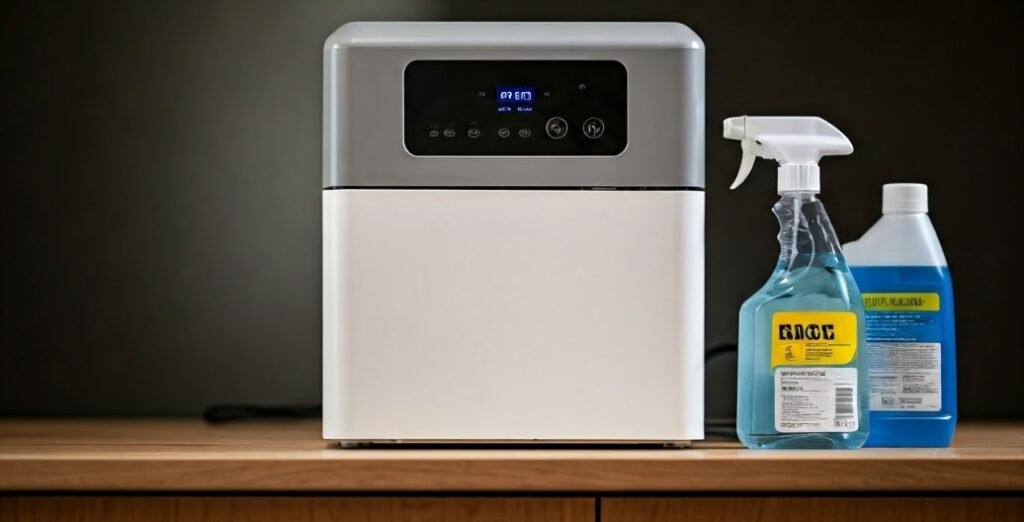After a wildfire, it’s very important to clean and check your home appliances. This is especially true for your ice maker. This guide will help you with a simple process on how to clean and inspect ice makers after a wildfire. It will ensure your Sub Zero ice maker is clear of harmful things like smoke, soot, and debris. This way, you can have clean and safe ice again.
The Health Hazards of Contaminated Ice
The ice from your ice maker may be affected by harmful substances from wildfires. Smoke and soot can carry these bad materials, which might land on your ice maker’s parts inside.
If these substances mix with the water used to make ice, they can get into the ice. Eating even small amounts of these harmful materials can build up in your body and cause health problems later on.
So, it is very important to have a careful cleaning process. You should use the right cleaning solutions to remove these contaminants and make sure the ice is safe to eat.
How Wildfires Affect Your Ice Maker’s Safety
Beyond contamination, wildfires can also affect the safety of your ice maker. The intense heat from a fire nearby can harm its electrical parts. This damage may lead to problems or even create a risk of fire later.
Debris from the wildfire, like ash or particles blown by the wind, can get inside the ice maker. This can cause blockages or damage that affects how well it works.
Clean and inspect your ice maker thoroughly to deal with these issues. This step is important for restoring its function. It helps the appliance last longer and keeps you safe.
Step-by-step guide for cleaning and inspecting ice makers
Cleaning an ice maker after a wildfire can look hard. However, it becomes easier if you follow simple steps. By using these clear instructions, you can remove any hazards and make sure your ice maker is safe to use.
Always focus on safety and don’t rush through the process.
Gather necessary supplies and protective gear
Before you start cleaning, get the supplies and protective gear you need:
- Cleaning solution: Mix warm water with mild dish soap or a cleaner made for appliances. Don’t use strong chemicals or rough cleaners. They can harm your ice maker.
- Cleaning tools: Use soft cloths or sponges, a soft brush, and a bucket for the cleaning solution. A container to catch the ice you throw away can also be useful.
- Protective gear: Put on gloves and safety goggles. They will keep your hands and eyes safe from harmful cleaners and debris.
Having everything ready helps the cleaning process go smoothly and lowers the chance of problems.
Disconnect power and water supply to the ice maker
Before starting any cleaning, make your safety the main priority. Unplug the ice maker from its power source. Find the circuit breaker that controls the ice maker and turn it off. This step is important to prevent electrical shock during cleaning.
Next, find the water supply line at the back of the ice maker. Slowly turn off the valve to stop the water from flowing. This will help avoid any leaks or spills while you clean.
By following these safety steps, you can create a safe space for cleaning without worrying about electric or water dangers.
Remove any visible debris or residue from the exterior of the ice maker
Now, let’s clean the outside of your ice maker. Take a slightly damp cloth or sponge and gently wipe the whole surface. This will help remove any dust, soot, or debris from the wildfire. Make sure to pay extra attention to small gaps and edges since dirt can gather there.
If you find tough spots that are hard to clean, don’t use harsh cleaners. They might scratch the surface. Instead, use a stronger cleaning solution and let it sit for a little while before wiping it off. Also, make sure the cloth you use is not too wet. This will help avoid letting extra moisture get into the appliance’s electrical parts.
Clean and sanitize all interior components of the ice maker
With the outside of your ice maker clean, now move to the inside. First, take out all the parts you can remove, like the ice bucket and trays. Wash them in warm, soapy water. Make sure to clean all corners and small spaces. Rinse them well and let them air dry completely.
Then, make your cleaning solution. Use warm water with mild dish soap or an appliance cleaner. Stay away from strong chemicals. They can leave residues and change the ice’s taste. Use a soft cloth or sponge to dip into the solution. Carefully wipe the walls and parts of the ice maker. Focus on spots where ice forms and touches the water.
Inspect for any damage or malfunctions
After you have cleaned and rinsed your ice maker, check it for any damage or problems from the wildfire. Look closely at all parts, including the water lines, connections, and the ice-making part. Check for any signs of melting, bending, or burns, which can show heat damage.
Also, look for loose wires or connections. They might have come undone during the wildfire. If you find any damage, do not use the ice maker. Instead, call a qualified technician or the manufacturer for help with repair or replacement.
Reconnect power and water supply and test the ice maker
Once you know the ice maker is clean and not damaged, you can reconnect it. Carefully attach the water supply line. Make sure the valve is closed tightly before you turn the water on. Check for any leaks at the connection.
After you confirm there are no leaks, plug the ice maker into the power outlet. Then, turn the circuit breaker back on. Let the ice maker run through a full ice-making cycle to check if it works. After the cycle is finished, throw away the first batch of ice to remove any leftover cleaning solution or bits that may be in it.
Dispose of any contaminated or damaged parts properly
If you find damaged or very dirty parts while cleaning and inspecting, you need to dispose of them correctly. Some parts, like electrical items or those with a lot of residue, may need special disposal methods based on local rules.
You should reach out to your local waste management facility or check online for their guidance on getting rid of appliances or electronic waste. They can help you with the right steps for your ice maker parts. This way, you can ensure that you dispose of them responsibly to protect the environment.
Conclusion
In summary, it’s very important to learn how to clean and inspect your ice maker after a wildfire. Wildfires can be dangerous for your health and may harm your ice maker. So, you need to do a proper cleaning. To do this, gather all your supplies, clear away any debris, sanitize the parts, and look for any damage. This will help keep your ice safe to use. If you are unsure about the safety of your ice maker after a wildfire, you should think about hiring a professional like us at Sub Zero Appliance Repair for a thorough cleaning and inspection. For more appliance tips, please check our blog on Mastering How to Get Rid of Ice Buildup in Freezer.
Frequently Asked Questions
Can smoke from wildfires contaminate my ice maker even if it’s indoors?
Yes, your Sub Zero ice maker is not completely safe, even inside. Smoke particles are very small. They can go through tiny cracks and openings. This could contaminate your ice maker and will need a deep cleaning.
How can one ensure that the ice produced by the machine is safe for consumption after being exposed to a wildfire?
To keep your ice safe after a wildfire, it’s important to clean everything well. Use the right cleaning solution. If your ice maker has a water filter, think about changing it too.
Are there professional services available for thoroughly cleaning and inspecting ice makers post-wildfire?
Yes, if you don’t want to clean your ice maker by yourself or think it might be badly damaged, you can call a professional. They can clean, check, and fix your ice maker really well.


